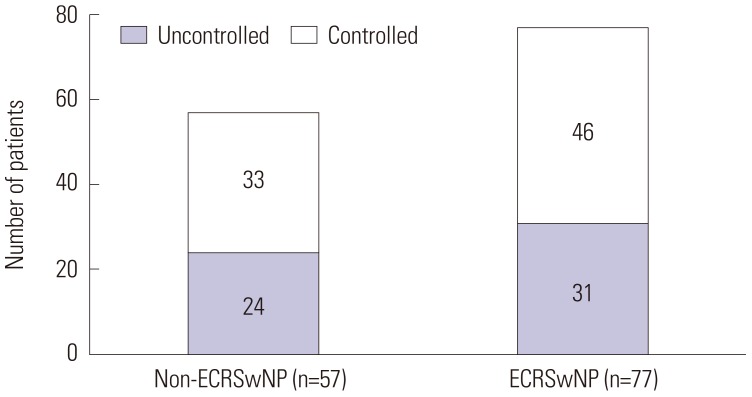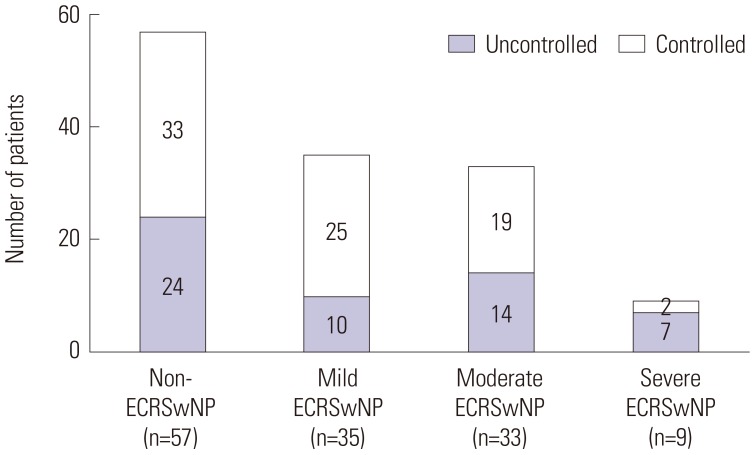Yonsei Med J.
2019 Jun;60(6):578-584. 10.3349/ymj.2019.60.6.578.
Revisiting the Clinical Scoring System for the Prognosis of Chronic Rhinosinusitis with Nasal Polyps
- Affiliations
-
- 1Department of Otorhinolaryngology-Head and Neck Surgery, Boramae Medical Center, Seoul Metropolitan Government-Seoul National University, Seoul, Korea. kicubi@daum.net
- 2Department of Otorhinolaryngology, Armed Forces Capital Hospital, Seongnam, Korea.
- KMID: 2446964
- DOI: http://doi.org/10.3349/ymj.2019.60.6.578
Abstract
- PURPOSE
To evaluate the Japanese Epidemiological Survey of Refractory Eosinophilic Chronic Rhinosinusitis (JESREC) classification, a clinical scoring system, for predicting disease control status in chronic rhinosinusitis with nasal polyps (CRSwNP) and to investigate prognostic factors.
MATERIALS AND METHODS
In total, 134 CRSwNP patients who underwent functional endoscopic sinus surgery after maximal medical treatment were enrolled. These patients were categorized into four groups according to JESREC classification: 1) non-eosinophilic CRSwNP (non-ECRSwNP), 2) mild eosinophilic CRSwNP (ECRSwNP), 3) moderate ECRSwNP, and 4) severe ECRSwNP. Disease control status among the patients was evaluated at 1 year after surgery, and the patients were divided into two groups (disease-controlled and disease-uncontrolled groups) for the investigation of prognostic factors.
RESULTS
There was no significant difference in disease control status between non-ECRSwNP and ECRSwNP groups (p=0.970). Age, Lund-Mackay CT scores, global osteitis scores, tissue neutrophil count, and tissue eosinophil count were associated with disease control status. In subgroup analysis of the non-ECRSwNP group, only high tissue neutrophil count was related with disease control status, whereas for the ECRSwNP group, young age, high Lund-Mackay CT scores, high global osteitis scores, and high tissue and blood eosinophil counts were associated with disease control status.
CONCLUSION
No difference in disease control status was identified between non-ECRSwNP and ECRSwNP cases. Tissue neutrophilia, however, appeared to be associated with disease control status in non-ECRSwNP cases, whereas tissue and blood eosinophilia was associated with ECRSwNP cases.
Keyword
MeSH Terms
Figure
Cited by 1 articles
-
Risk Model Establishment of Endoscopic Sinus Surgery for Patients with Chronic Rhinosinusitis: a Multicenter Study in Korea
Jin-Young Min, Yong Min Kim, Dae Woo Kim, Jeong-Whun Kim, Jin Kook Kim, Ji-Hun Mo, Jae-Min Shin, Kyu-Sup Cho, Sanggyu Kwak, Seung-Heon Shin
J Korean Med Sci. 2021;36(40):e264. doi: 10.3346/jkms.2021.36.e264.
Reference
-
1. Polzehl D, Moeller P, Riechelmann H, Perner S. Distinct features of chronic rhinosinusitis with and without nasal polyps. Allergy. 2006; 61:1275–1279. PMID: 17002702.
Article2. Cho SH, Kim DW, Lee SH, Kolliputi N, Hong SJ, Suh L, et al. Age-related increased prevalence of asthma and nasal polyps in chronic rhinosinusitis and its association with altered IL-6 trans-signaling. Am J Respir Cell Mol Biol. 2015; 53:601–606. PMID: 26266960.
Article3. Shin HW, Kim DK, Park MH, Eun KM, Lee M, So D, et al. IL-25 as a novel therapeutic target in nasal polyps of patients with chronic rhinosinusitis. J Allergy Clin Immunol. 2015; 135:1476–1485. PMID: 25725991.
Article4. Kim DW, Kim DK, Jo A, Jin HR, Eun KM, Mo JH, et al. Age-related decline of neutrophilic inflammation is associated with better postoperative prognosis in non-eosinophilic nasal polyps. PLoS One. 2016; 11:e0148442. PMID: 26849431.
Article5. Kim DK, Jin HR, Eun KM, Mo JH, Cho SH, Oh S, et al. The role of interleukin-33 in chronic rhinosinusitis. Thorax. 2017; 72:635–645. PMID: 27885166.
Article6. Kim DW, Kulka M, Jo A, Eun KM, Arizmendi N, Tancowny BP, et al. Cross-talk between human mast cells and epithelial cells by IgE-mediated periostin production in eosinophilic nasal polyps. J Allergy Clin Immunol. 2017; 139:1692–1695. PMID: 27771323.
Article7. Kim DW, Cho SH. Emerging endotypes of chronic rhinosinusitis and its application to precision medicine. Allergy Asthma Immunol Res. 2017; 9:299–306. PMID: 28497916.
Article8. Tokunaga T, Sakashita M, Haruna T, Asaka D, Takeno S, Ikeda H, et al. Novel scoring system and algorithm for classifying chronic rhinosinusitis: the JESREC Study. Allergy. 2015; 70:995–1003. PMID: 25945591.9. Deal RT, Kountakis SE. Significance of nasal polyps in chronic rhinosinusitis: symptoms and surgical outcomes. Laryngoscope. 2004; 114:1932–1935. PMID: 15510016.
Article10. Kim DK, Jin HR, Eun KM, Mutusamy S, Cho SH, Oh S, et al. Non-eosinophilic nasal polyps shows increased epithelial proliferation and localized disease pattern in the early stage. PLoS One. 2015; 10:e0139945. PMID: 26439628.
Article11. Fokkens WJ, Lund VJ, Mullol J, Bachert C, Alobid I, Baroody F, et al. EPOS 2012: European position paper on rhinosinusitis and nasal polyps 2012. A summary for otorhinolaryngologists. Rhinology. 2012; 50:1–12. PMID: 22469599.
Article12. Nam YH, Jeon DS, Lee SK. Comparison of skin prick test and serum specific IgE measured by ImmunoCAP system for various inhalant allergens. Allergy Asthma Respir Dis. 2015; 3:47–53.
Article13. Georgalas C, Videler W, Freling N, Fokkens W. Global Osteitis Scoring Scale and chronic rhinosinusitis: a marker of revision surgery. Clin Otolaryngol. 2010; 35:455–461. PMID: 21199405.
Article14. Kim DW, Kim JY, Jeon SY. The status of the olfactory cleft may predict postoperative olfactory function in chronic rhinosinusitis with nasal polyposis. Am J Rhinol Allergy. 2011; 25:e90–e94. PMID: 21679509.
Article15. Bachert C, Zhang N, van Zele T, Gevaert P. Chronic rhinosinusitis: from one disease to different phenotypes. Pediatr Allergy Immunol. 2012; 23(Suppl 22):2–4.
Article16. Akdis CA, Bachert C, Cingi C, Dykewicz MS, Hellings PW, Naclerio RM, et al. Endotypes and phenotypes of chronic rhinosinusitis: a PRACTALL document of the European Academy of Allergy and Clinical Immunology and the American Academy of Allergy, Asthma & Immunology. J Allergy Clin Immunol. 2013; 131:1479–1490. PMID: 23587334.17. Nakayama T, Yoshikawa M, Asaka D, Okushi T, Matsuwaki Y, Otori N, et al. Mucosal eosinophilia and recurrence of nasal polyps - new classification of chronic rhinosinusitis. Rhinology. 2011; 49:392–396. PMID: 21991563.
Article18. Soler ZM, Sauer DA, Mace J, Smith TL. Relationship between clinical measures and histopathologic findings in chronic rhinosinusitis. Otolaryngol Head Neck Surg. 2009; 141:454–461. PMID: 19786212.
Article19. Tecimer SH, Kasapoglu F, Demir UL, Ozmen OA, Coskun H, Basut O. Correlation between clinical findings and eosinophil/neutrophil ratio in patients with nasal polyps. Eur Arch Otorhinolaryngol. 2015; 272:915–921. PMID: 25007735.
Article20. Kim SY, Park JH, Rhee CS, Chung JH, Kim JW. Does eosinophilic inflammation affect the outcome of endoscopic sinus surgery in chronic rhinosinusitis in Koreans? Am J Rhinol Allergy. 2013; 27:e166–e169. PMID: 24274208.
Article21. Lou H, Meng Y, Piao Y, Zhang N, Bachert C, Wang C, et al. Cellular phenotyping of chronic rhinosinusitis with nasal polyps. Rhinology. 2016; 54:150–159. PMID: 26747641.
Article22. Liao B, Liu JX, Li ZY, Zhen Z, Cao PP, Yao Y, et al. Multidimensional endotypes of chronic rhinosinusitis and their association with treatment outcomes. Allergy. 2018; 73:1459–1469. PMID: 29331025.
Article23. Wang H, Li ZY, Jiang WX, Liao B, Zhai GT, Wang N, et al. The activation and function of IL-36γ in neutrophilic inflammation in chronic rhinosinusitis. J Allergy Clin Immunol. 2018; 141:1646–1658. PMID: 29274415.
Article
- Full Text Links
- Actions
-
Cited
- CITED
-
- Close
- Share
- Similar articles
-
- Medical treatment according to phenotypes of chronic rhinosinusitis
- Tissue Remodeling in Rhinosinusitis
- Practical Review of Biologics in Chronic Rhinosinusitis With Nasal Polyps
- Nasalance Changes after Endoscopic Sinus Surgery in Patients with Chronic Rhinosinusitis
- Role of Fungal and Bacterial Superantigen in the Pathogenesis of Chronic Rhinosinusitis with Polyps





